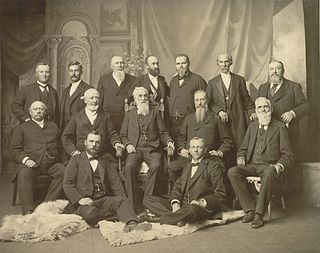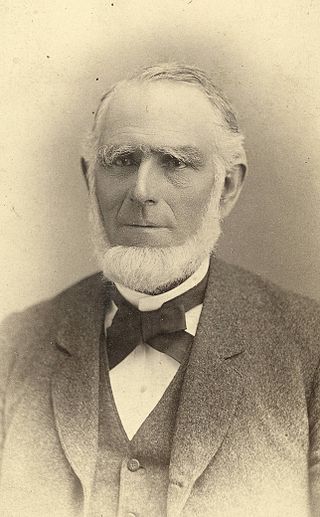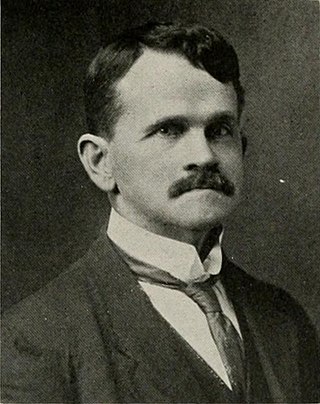External links
- Mark L. Grover at the MLCA Database
Mark L. Grover (born 1947) [1] is an American expert on Mormonism [ citation needed ] in Brazil and an author on religion in Latin America.
Grover was born in Malad, Idaho and is a member of the Church of Jesus Christ of Latter-day Saints (LDS Church). He served as a Mormon missionary in Brazil. He has a Ph.D. in Brazilian History from Indiana University.
Grover works as the subject area librarian for Latin America at the Harold B. Lee Library at Brigham Young University.
Grover is the author of several books related to the LDS Church and Brazil and at times focusing more broadly on Latin America and religion in general. He has compiled multiple bibliographies related to the LDS Church in Latin America and Mexican-Americans in Utah. [2]
Stephen Edward Robinson was a religious scholar and apologist, who was a member of the Church of Jesus Christ of Latter-day Saints.

In the Church of Jesus Christ of Latter-day Saints, the Quorum of the Twelve Apostles is one of the governing bodies in the church hierarchy. Members of the Quorum of the Twelve Apostles are apostles, with the calling to be prophets, seers, and revelators, evangelical ambassadors, and special witnesses of Jesus Christ.
During the history of the Latter Day Saint movement, the relationship between Black people and Mormonism has included enslavement, exclusion and inclusion, official and unofficial discrimination, and friendly ties. Black people have been involved with the Latter Day Saint movement since its inception in the 1830s. Their experiences have varied widely depending on the specific denomination within Mormonism, and the time in history of their involvement. From the mid-1800s to 1978, Mormonism's largest denomination, the Church of Jesus Christ of Latter-day Saints barred Black women and men from participating in ordinances of its temples necessary for the highest level of salvation, prevented most men of Black African descent from being ordained to the church's lay, all-male priesthood, supported racial segregation in its communities and schools, taught that righteous Black people would be made White after death, and opposed interracial marriage. The temple and priesthood racial restrictions were lifted by top leaders in 1978. In 2013 the church disavowed its previous teachings on race for the first time.

Abraham Owen Smoot was an American pioneer, businessman, religious leader, and politician. He spent his early life in the Southern United States and was one of seven children. After being baptized a member of the Church of Christ, predecessor to the Church of Jesus Christ of Latter-day Saints, Smoot served as a missionary in Kentucky, Tennessee, South Carolina, and England. He received no formal education, but learned to read as a child and later attended the School of the Prophets in Kirtland, Ohio. Like other early members of the LDS Church, Smoot practiced plural marriage, eventually marrying six women and having 24 children. After migrating west to Utah Territory, he was elected as the second mayor of Salt Lake City and maintained this position from 1857 to 1866. He was then assigned by Brigham Young to move to Provo, where he served as stake president and mayor from 1868 to 1881. He assisted financially in the construction of the Provo Tabernacle—today the Provo City Center Temple—as well as that of the Utah Southern Railroad. Smoot was the first president of the board of trustees of Brigham Young Academy (BYA)—which later developed into Brigham Young University (BYU). He was an early financial supporter of the institution and was nicknamed the "foster father" of the academy. His goal was to make education available to young Latter-day Saints. Today, the Smoot Administration Building at BYU is named after him.
Thomas Glen Alexander is an American historian and academic who is a professor emeritus at Brigham Young University (BYU) in Provo, Utah, where he was also Lemuel Hardison Redd, Jr. Professor of Western History and director of the Charles Redd Center for Western Studies. After studying at Weber State University (WSU) and Utah State University (USU), he received a PhD from the University of California, Berkeley in 1965. He taught history at BYU from 1964 until 2004, and served in the leadership of various local and historical organizations.

Many members of the Latter Day Saint movement believe that the Book of Mormon is historically accurate. Most, but not all, Mormons hold the book's connection to ancient American history as an article of their faith. This view finds no confirmation outside of Mormonism in the broader scientific community. Mainstream archaeological, historical, and scientific communities do not consider the Book of Mormon an ancient record of actual historical events.
Marcus Helvécio Martins is the former dean and department chair for religious education at Brigham Young University–Hawaii (BYU–Hawaii), and also the author of Setting the Record Straight: Blacks and the Mormon Priesthood. Martins was the first black member to serve as a missionary after the revelation extending the priesthood of the Church of Jesus Christ of Latter-day Saints to all male members regardless of race or color. Martins is the son of Helvécio Martins, the first Latter-day Saint of African descent to serve as an LDS Church general authority.
Dean Cornell Jessee is a historian of the early Latter Day Saint movement and leading expert on the writings of Joseph Smith Jr.
James Brown "Jim" Allen is an American historian of Mormonism and was an official Assistant Church Historian of the Church of Jesus Christ of Latter-day Saints from 1972 to 1979. While working as Assistant Church Historian, he co-authored The Story of the Latter-day Saints with Glen Leonard. After Ezra Taft Benson dismissed the book as secular new history, other events led to the dissolution of the LDS Church History department in 1982. Allen resigned as Assistant Church Historian in 1979, returning to work at Brigham Young University (BYU) full-time.
Richard Eyring "Rick" Turley Jr. is an American historian and genealogist. He previously served as both an Assistant Church Historian of the Church of Jesus Christ of Latter-day Saints and as managing director of the church's public affairs department.
Grant Revon Underwood is a historian of the Church of Jesus Christ of Latter-day Saints and a professor at Brigham Young University (BYU). He is also the author of The Millennial World of Early Mormonism and the editor of Voyages of Faith: Explorations in Mormon Pacific History.
Reed Connell Durham, Jr. is a historian of the Latter Day Saint movement and former director of the Institute of Religion in Salt Lake City, Utah for the Church of Jesus Christ of Latter-day Saints. Durham is remembered for a controversial speech given in 1974 about Freemasonry and the Latter Day Saint movement.

Ellis Theo Rasmussen was an American professor and dean of Religious Instruction at Brigham Young University (BYU). He helped produce the edition of the Bible published by the Church of Jesus Christ of Latter-day Saints in 1979.
Marvin Sidney Hill (1928–2016) was a professor of American history at Brigham Young University (BYU) and a historian of the Latter Day Saint movement.
Mormon studies is the interdisciplinary academic study of the beliefs, practices, history and culture of individuals and denominations belonging to the Latter Day Saint movement, a religious movement associated with the Book of Mormon, though not all churches and members of the Latter Day Saint movement identify with the terms Mormon or Mormonism. Denominations of the Latter Day Saint movement include the Church of Jesus Christ of Latter-day Saints, by far the largest, as well as the Community of Christ (CoC) and other smaller groups, include some categorized under the umbrella term Mormon fundamentalism.

Since Mormonism’s foundation, Black people have been members, however the church placed restrictions on proselytization efforts among Black people. Before 1978, Black membership was small. It has since grown, and in 1997, there were approximately 500,000 Black members of the church, mostly in Africa, Brazil and the Caribbean. Black membership has continued to grow substantially, especially in West Africa, where two temples have been built. By 2018, an estimated 6% of members were Black worldwide. In the United States, approximately 1% of members are Black.

William Henry Chamberlin Jr. was an American Mormon philosopher, theologian, and educator. His teachings and writings worked to reconcile Mormonism with the theory of evolution. He taught philosophy and ancient languages as well as science and math at several Latter-day Saints (LDS) institutions including Brigham Young University in the early 20th century. He was one of four educators at Brigham Young University whose teaching of evolution and attempts to reconcile it with Mormon thought, although strongly popular with students, generated controversy among university officials and the LDS community. Chamberlin has been called "Mormonism's first professionally trained philosopher and theologian."

The following outline is provided as an overview of and a topical guide to the Church of Jesus Christ of Latter-day Saints.

The 1911 modernism controversy at Brigham Young University was an episode involving four professors at Brigham Young University (BYU), who between 1908 and 1911 widely taught evolution and higher criticism of the Bible, arguing that modern scientific thought was compatible with Christian and Mormon theology. The professors were popular among students and the community but their teachings concerned administrators, and drew complaints from stake presidents, eventually resulting in the resignation of all four faculty members, an event that "leveled a serious blow to the academic reputation of Brigham Young University—one from which the Mormon school did not fully recover until successive presidential administrations."